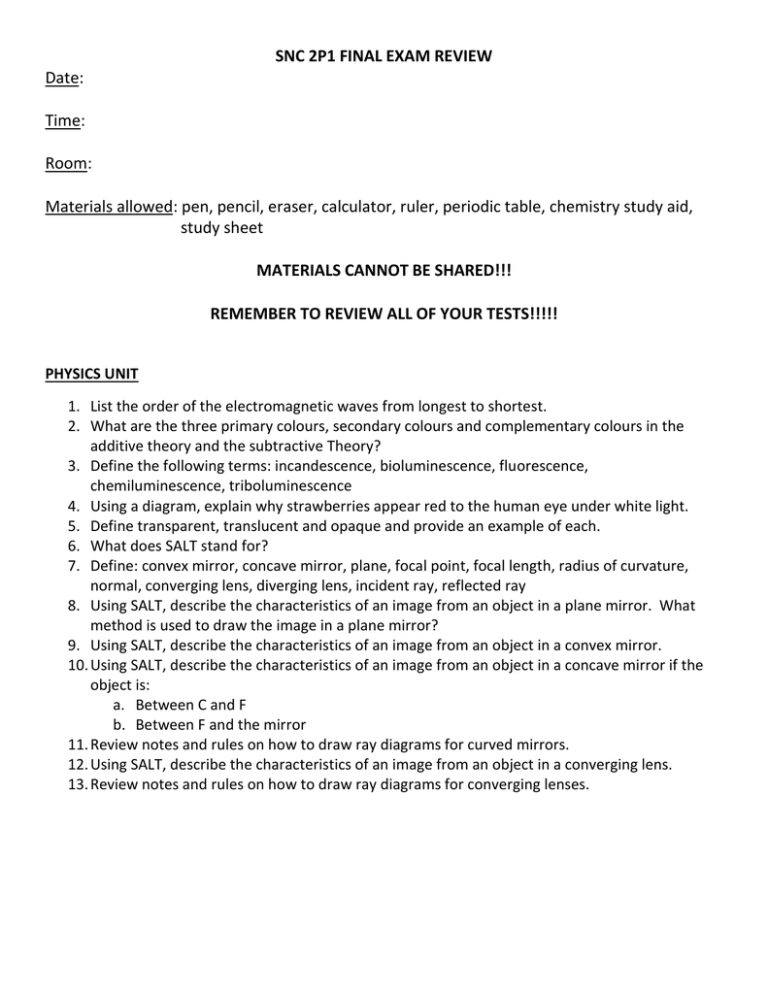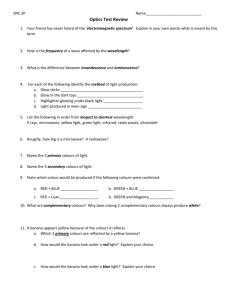SNC 2P1 FINAL EXAM REVIEW Date: Time: Room:
advertisement

SNC 2P1 FINAL EXAM REVIEW Date: Time: Room: Materials allowed: pen, pencil, eraser, calculator, ruler, periodic table, chemistry study aid, study sheet MATERIALS CANNOT BE SHARED!!! REMEMBER TO REVIEW ALL OF YOUR TESTS!!!!! PHYSICS UNIT 1. List the order of the electromagnetic waves from longest to shortest. 2. What are the three primary colours, secondary colours and complementary colours in the additive theory and the subtractive Theory? 3. Define the following terms: incandescence, bioluminescence, fluorescence, chemiluminescence, triboluminescence 4. Using a diagram, explain why strawberries appear red to the human eye under white light. 5. Define transparent, translucent and opaque and provide an example of each. 6. What does SALT stand for? 7. Define: convex mirror, concave mirror, plane, focal point, focal length, radius of curvature, normal, converging lens, diverging lens, incident ray, reflected ray 8. Using SALT, describe the characteristics of an image from an object in a plane mirror. What method is used to draw the image in a plane mirror? 9. Using SALT, describe the characteristics of an image from an object in a convex mirror. 10. Using SALT, describe the characteristics of an image from an object in a concave mirror if the object is: a. Between C and F b. Between F and the mirror 11. Review notes and rules on how to draw ray diagrams for curved mirrors. 12. Using SALT, describe the characteristics of an image from an object in a converging lens. 13. Review notes and rules on how to draw ray diagrams for converging lenses. CHEMISTRY UNIT 1. 2. 3. 4. 5. 6. 7. Define the following terms: element, compound, mixture, solution, atom and ion. How many electrons can the first, second, and third electron shells hold? Describe the difference between electrons, protons and neutrons. What is a physical change? Provide 2 examples. What are the five clues that a chemical change has occurred? How do atoms become negatively charged? How do atoms become positively charged? Do the following atoms have a tendency to gain or lose electrons? What is the resulting charge? a. Lithium e. Argon b. Oxygen f. Boron c. Magnesium g. Chlorine d. Phosphorus 8. Where are the metals, non-metals and metalloids located on the periodic table? 9. What is a period? What is a group? 10. Elements in the same vertical column have what in common? Elements in the same horizontal column have what in common? 11. What elements make up ionic compounds? What elements make up molecular compounds? 12. What are the steps to naming and writing chemical formulas for ionic compounds? 13. What are the steps to naming and writing chemical formulas for molecular compounds? 14. What are the steps to naming and writing chemical formulas for polyatomic compounds? 15. Give the compound name or the chemical formula as required: a. K2S i. NaOH q. Carbon tetrafluoride b. Ag2O j. Ca(NO3)2 r. Nitrogen dioxide c. AlBr3 k. CaCO3 s. Diphosphorous trioxide d. ZnF2 l. Ba3(PO4)2 t. Lithium carbonate e. H2O m. Sodium oxide u. Calcium phosphate f. P2O3 n. Lithium iodide v. Aluminum hydroxide g. SiO2 o. Calcium nitride w. Barium sulfate h. CO2 p. Dinitrogen monoxide 16. Using Lewis dot diagrams, show how calcium and phosphorus for a compound. Show the resulting ions. Provide the chemical name and chemical formula. 17. What are the four types of reactions? 18. Balance the following chemical equations and classify the type of reaction: a. ____ Sb + ____ I2 ____SbI3 b. ____ Li + ____ H2O ____ LiOH + ____ H2 c. ____ H2O ____ H2 + ____ O2 d. ____ AlCl3 ____ Al + ____ Cl2 e. ____ AlCl3 + ____ Na2CO3 ____ Al2(CO3)3 + ____ NaCl f. ____ HNO3 + ____ Ba(OH)2 ____ Ba(NO3)2 + ____ H2O BIOLOGY UNIT 1. State the five characteristics of living things. 2. Define the following terms: cell, cytoplasm, cell membrane, cilia, mitochondria, vacuole, nucleus, chromosomes, carcinogen 3. How many chromosomes do humans have? 4. What is cancer? What is a tumour? Describe the difference between a benign and a malignant tumour. 5. Explain sexual and asexual reproduction. 6. Explain the difference between diffusion and osmosis. 7. State the three reasons for cell division. 8. Why is it important for cells to divide and stay small rather than grow larger? 9. Put the following terms in order from the most simple to the most complex: organ system, tissue, organism, organ, cell 10. The red blood cells have a specific shape. What purpose does this serve? 11. Provide two examples of where nerve tissue can be found. 12. What is the main purpose of epithelial cells (skin)? 13. What gases are part of gas exchange and where does it specifically occur? 14. What are the three types of blood vessels? Explains the function of each. 15. What are the four processes carried out by the digestive system? 16. Review the diagram of the digestive system. Trace the path of food from the beginning to the end of digestion. 17. Review the diagrams of the circulatory and respiratory systems. Be able to label the diagrams and explain the function of each structure. CLIMATE CHANGE UNIT 1. 2. 3. 4. 5. Compare weather and climate. Define heat sink and carbon sink. What is the greenhouse effect? Why is it warmer near the equator than near the poles? Explain using a diagram. Explain the anthropogenic greenhouse effect. What four gases are part of this greenhouse effect and what human activities are contributing to their increase? 6. Why is it important to replant trees? How do trees help control the levels of carbon dioxide in the atmosphere? 7. Describe the carbon footprint and how you can reduce it. 8. Using a diagram, explain what happens to the energy from the Sun as it hits the Earth’s atmosphere. 9. What are the components of the Earth’s Climate System and how does each help to keep the Earth’s global temperature stable? 10. Explain/Describe all of the main evidence of the earth’s changing climate. 11. List and explain the four main global impacts of climate change.


